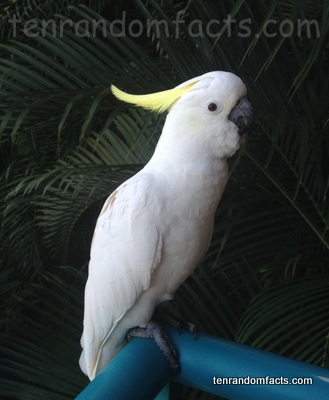Sulphur-crested cockatoos are majestic and marvellous birds.
- Sulphur-crested cockatoos are a group of birds that contain four subspecies, native to Papua New Guinea and eastern, northern and some southern areas of Australia.
- The scientific name of a sulphur-crested cockatoo is Cacatua galerita, and it is from the family Cacatuidae, the family of cockatoos.
- Sulphur-crested cockatoos have been introduced into Australia’s Perth in Western Australia, Asia’s Singapore, and New Zealand, along with other Pacific Islands.
- Sulphur-crested cockatoos typically grow to heights of 44 to 55 centimetres (17 to 22 inches); they can weigh as much as 950 grams (34 ounces); and they can live up to 80 years, however, their lifespan in the wild is generally between 20 and 40 years.
- A sulphur-crested cockatoo has white coloured feathers, a vivid yellow crest, and a grey coloured beak; and their feathers are waterproof due to a thin, special powder that they excrete.
- Seeds, berries, nuts, roots, and other vegetation make up the diet of sulphur-crested cockatoos and they generally live in family groups in forest habitats or where there are plenty of trees.
- Female sulphur-crested cockatoos have clutches of one to three eggs, which are laid in a tree cavity, and the young are raised by both parents.
- Some people consider sulphur-crested cockatoos as pests, even in native areas, as large populations can destroy crops, and they can also damage buildings with their sharp parrot beaks, as they like to chew wood.
- When a group of sulphur-crested cockatoos are scavenging for food on a ground surface, a single bird from the flock is commonly found perching on a high platform watching for predators.
- Sulphur-crested cockatoos generally make loud screeching noises; they are capable of imitating speech and other sounds; and are occasionally kept as pets.
Bibliography:
Sulphur-crested Cockatoo, 2015, Australian Museum, http://australianmuseum.net.au/sulphur-crested-cockatoo
Sulphur-crested Cockatoo, 2015, Wikipedia, http://en.wikipedia.org/wiki/Sulphur-crested_cockatoo
Sulphur-crested Cockatoo, n.d, Zoos Victoria, http://www.zoo.org.au/healesville/animals/sulphur-crested-cockatoo







